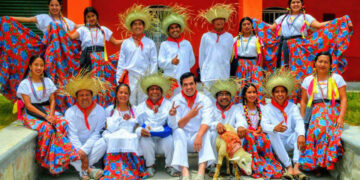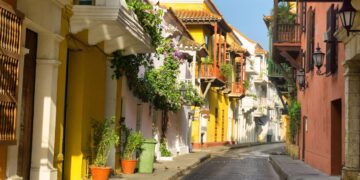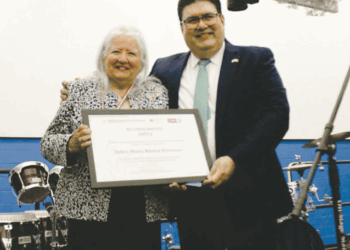I have previously written about Casa de Unidad, often just called “Casa”. During its existence Casa was the premier arts/cultural organization serving southwest Detroit’s Latino community. Previous articles covered the origins of the organization, the annual Unity in the Community Festival which they hosted for close to twenty-five years and its youth arts and mentorship program Tradiciones Vivas. The latter coordinated by its printer David Conklin. Recently EL CENTRAL revisited the day when Tito Puente hung out in southwest Detroit while attending a community appreciation dinner hosted by the organization. This article highlights many of the contributions of one of its directors, Ana Cardona. Upon assuming leadership Casa truly flourished and its influence was enhanced. It is a humble attempt to start telling her story which I hope can be the subject of a longer article down the road.
I remember first meeting Ana in 1983 when she interviewed for the position of Cultural Center Director at Casa, a position I had just vacated after becoming its first and founding director. She was encouraged by fellow U of M art history grad student George Vargas to apply for the Cultural Center Director’s position. Vargas would later gain national acclaim for his artistic and educational work. Drawn to the idea of community-based arts Ana met with fellow Casa de Unidad board member and photographer Dolores Gonzales and myself. There was no doubt in our minds that she was the right person. I can only say that was an understatement.
Originally from the South Bronx she found herself at the University of Michigan in Ann Arbor for her graduate studies on the history of art and adult and continuing education. Though she found herself without a traditional advisor, she was fortunate to count among her key mentors, the great Detroit based African American poet Murray Jackson who was a professor at the university’s School of Education and an administrator within that school’s Office of Minority Affairs.
Ana along with Guadalupe “Lupe” Aguirre, who would become the center’s assistant director, had a great impact on the cultural life of southwest Detroit, the city and ultimately on the state’s educational and artistic community. When she joined Casa de Unidad was located in what was then Hispanos Unidos, located on the northeast corner of 25th Street and W. Vernor, now home to Southwest Housing Solutions. Soon after Casa moved to 1920 Scotten, around the corner from LA SED. Casa received regular funding from the Michigan Council of the Arts, the City of Detroit’s Neighborhood Opportunity Funds (NOF), the Detroit Council of the Arts, and occasionally the National Endowment of the Arts among other sources.
During our phone interview Ana fondly recalled some key aspects of her time there. She spoke highly of David Conklin whom she was able to recruit to be the organization’s printer. With his assistance Casa established a professional printing business. This allowed for the printing of “El Barrio”, an arts and community publication. Casa essentially became the community’s “go to” printer and publisher. Over the years they were instrumental in documenting the people, community life, major events and daily activities of southwest Detroit, not only through El Barrio, but also with other publications such “Personas del Barrio”, among others. The press’ viability and excellence took a major step forward when they recruited George Perazza to serve as their primary in-house graphic artist. Since the press was highly regarded and in demand the quality of “signage” throughout the community also vastly improved. The press generated significant funds which often was used as “matching” sources for the various grants they applied for. She noted “It stretched the little budget we had!”
As our conversation progressed, we reflected on the fact that though Casa was a community- based organization and relatively small, it exerted an outsized influence beyond southwest Detroit, impacting the city and to a certain extent the state of Michigan. Its productivity was surprising. The center also became a gathering place for Latino and non-Latino artists, musicians and organizers and helped to spark the creative spirit in southwest Detroit that was to continue for a couple of decades. National and sometimes internationally renowned artists, musicians, poets and community activists often dropped by. It is no exaggeration to say Casa had a national influence.

She remembers Jackie Sanchez and the Latino Poets Association being a bedrock of support and programming. Their relationship led to the publication by Casa of a number of poetry books and their sponsorship of live poetry readings in their “Flor Y Canto” series. Numerous gallery art exhibits were curated and annually they organized the historic Unidad En La Comunidad (Unity in the Community) Festivals, which was attended by thousands. A number of stand-alone film showings and concerts can be added to its list of programming.
Ana’s commitment to documenting our community led to a number of oral history projects most notably the long-term collaboration with Michigan State University and Laurie Sommers. Oral history interviews with residents were conducted and led to the publication of two books, Fiesta, Fe Y Cultura and Tradiciones del Pueblo. These books highlighted some of Detroit’s Latino community cultural practices.
One of her fondest memories relates to the organizing of the Tito Puente community recognition dinner. She remembers going to grocery stores in the community, securing donations and working closely with the Puerto Rican women who cooked the dinner.
Over the years I have had the good fortune of staying in touch with her after she left Detroit, and moved to Lansing, MI to work with the State of Michigan’s Department of Education. She landed at the Department’s King-Chavez-Parks Initiative, tasked with increasing the number of students of color in state universities and colleges. She would later go on to become the Department of Education’s key Arts in Education Specialist. In that role she worked with different school districts and groups of educators to enhance the critical role of arts in education. Many of her colleagues noted that in addition to being an effective and supportive administrator she was a tireless internal “advocate” at the State for the infusion of arts-based education.
As we discussed her view towards the infusion of arts in community and educational work
Ana credits being exposed to the work of Jack and Irene Delano who were famous for their community-based work, particularly on the island of Puerto Rico. The couple were an award- winning photographer and graphic artist respectively. Ana and her husband, photographer Julio Perazza, were in Puerto Rico exploring the use of images and words in art-based work with Puerto Rican elders. That interest led them to seek Jack Delanos while on the island. Though Ana and Julio arrived in Puerto Rico after Irene’s passing, they met Jack and soon interviewed him in what she stated was an amazing experience. They were to maintain a long- term friendship and Ana organized state side exhibits of his work.
She went on to explain how the Delanos, assigned to document daily life on the island by the federal government’s Farm Security Administration during the Great Depression, became famous for their groundbreaking work in documenting its people and island “life”. Their commitment to the island and its people would continue for decades to follow. They and other cultural workers would go throughout rural and small-town communities into the 50’s to do their community based art work.
In 1987 she moved from Casa to go work the Detroit Council of the Arts and was there a couple of years before going on to the State’s Department of Education as detailed above. Upon her retirement from the State, she helped found the Michigan Art Education Instruction and Assessment (MAEIA) and consulted for them for 8 years. She considers this a high point in her career. MAEIA works with educators throughout the state in the area of dance, music, theater and visual arts. Ana is proud of the fact that this work continues with “new blood”.
It was such a pleasure talking to Ana Cardona not only because we reviewed her life work but because I could see her arts and educational activism. Her influence continues to reign and influence many!
Ozzie Rivera, a retired social worker, is a cultural activist and musician who currently teaches on Afro Latino History and Culture at Wayne State University and social work at the University of Michigan.














































